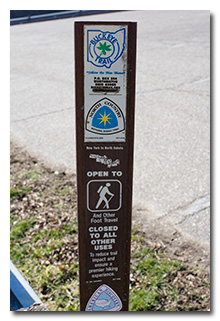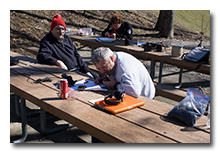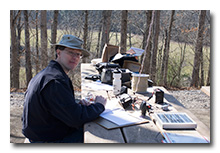
by William Eric McFadden
Pictures
- The North Country National Scenic Trail trailhead marker
- Eric's station
- Andy operating while Bob watches
- Eric operating; photo by Miles McFadden
- Public Information Table—Five Star Activator activity
- Screencap: ACARA Facebook announcement of the activation—Five Star Activator activity
- Screencap: NPOTA Facebook announcement of the activation—Five Star Activator activity
Description
 Three members of the Southeast Ohio Radio Adventure Team succeeded in activating
North Country National Scenic Trail as part of the ARRL's year-long National Parks on the Air
(link). Eric McFadden, WD8RIF; Miles McFadden, KD8KNC; and
Andy Young, KD8WVX traveled to Tom Jenkins Dam in Burr Oak State Park to activate the North
Country National Scenic Trail, TR04 (link). The trio
was joined by Bob Curtis, KD8FRQ, who helped set up the stations.
Three members of the Southeast Ohio Radio Adventure Team succeeded in activating
North Country National Scenic Trail as part of the ARRL's year-long National Parks on the Air
(link). Eric McFadden, WD8RIF; Miles McFadden, KD8KNC; and
Andy Young, KD8WVX traveled to Tom Jenkins Dam in Burr Oak State Park to activate the North
Country National Scenic Trail, TR04 (link). The trio
was joined by Bob Curtis, KD8FRQ, who helped set up the stations.
After a site-survey the day before, Andy and Eric decided to set up in the picnic area adjacent to the trail head. This picnic area provided many picnic tables and numerous trees from which to hang antennas. (The site-survey had revealed a second possible location actually on the trail. Perhaps this other location might be used for a subsequent activation.)
The trio arrived on-site about 10am. Andy quickly suspended a borrowed 10m-40m trap dipole from a very nicely-placed branch and set up his Kenwood TS-480sat transceiver. Eric's quiet 2kW Honda inverter-generator was used to provide power for Andy's 100-watt rig.
Eric spent an inordinate amount of time trying to get a line into a tree but finally succeeded in hanging his 44' speaker-wire field doublet. Midway through the activation, the string supporting one of the doublet legs slipped from the end-insulator and Eric deployed his 28' end-fed wire to use in place of the doublet. Eric's station was his KX3 Travel Kit powered by a 5Ah gel-cell with a 5-watt solar panel charging the battery. Eric had bought four additional gel-cells and his NiMH battery pack but none of these were needed. Having spent the previous two years using first a bug and a sideswipers/cootie-keys, Eric had great difficulty using the KX3's electronic keyer and ended up using the KX3's memory-keyer to call CQ and his Vibroplex bug to to complete the QSOs.
 Using his own callsign, Andy commenced SSB operations while Eric was struggling to hang his
antenna and quickly generate a significan pile-up. Andy very quickly achieved the ten QSOs required
to make an accredited activation and by the end of the operation, Andy had worked 118 stations on
40m, 20m, 15, 10m, and 2m. One station each was worked on 15m, 10m, and 2m and the rest were about
evenly split on 40m and 20m. Ted Jacobson, W8KVK, has generated a geocoded map of Andy's QSOs (link).
Note the 20m contact with North Pole, Alaska.
Using his own callsign, Andy commenced SSB operations while Eric was struggling to hang his
antenna and quickly generate a significan pile-up. Andy very quickly achieved the ten QSOs required
to make an accredited activation and by the end of the operation, Andy had worked 118 stations on
40m, 20m, 15, 10m, and 2m. One station each was worked on 15m, 10m, and 2m and the rest were about
evenly split on 40m and 20m. Ted Jacobson, W8KVK, has generated a geocoded map of Andy's QSOs (link).
Note the 20m contact with North Pole, Alaska.
Eric also managed to generate a couple of pile-ups as the activation progressed but his QRP CW signal didn't generate the interest that Andy's 100-watt SSB signal did. Still, Eric managed to achieve an accredited activation by working 41 stations, all on 20m except for one on 40m and one on 2m. Jean Charron, VE2JCW, sent Eric a recording of Eric working through a pile-up as heard in Quebec (link).
 Eric quickly discovered that he couldn't operate the same band as Andy—even the KX3's
excellent receiver couldn't reject Andy's 100-watt SSB signal when Eric was in the CW sub-band. This
issue was reduced somewhat once Eric switched to the 28' end-fed wire antenna.
Eric quickly discovered that he couldn't operate the same band as Andy—even the KX3's
excellent receiver couldn't reject Andy's 100-watt SSB signal when Eric was in the CW sub-band. This
issue was reduced somewhat once Eric switched to the 28' end-fed wire antenna.
Miles didn't operate but helped tremendously during set-up and tear-down and also cooked a nice lunch.
Except for the blustery winds, the weather was just about perfect for this activation. The temperature was in the high 40s during set-up and quickly rose to the mid-60s as operations commenced. It did not at all feel like a February day in Ohio.
Andy was impressed with the performance of the borrowed trap-dipole and has plans to make one of his own. Eric was less impressed with the performance of his 44' field-doublet and has ordered parts from SOTABEAMS (link) to build a 20m/40m trap-dipole of his own for field use.
Both Eric and Andy are excited about the possibilities for future activations, of North Country National Scenic Trail (TR04), and of Dayton Aviation Heritage (HP11), and maybe even of other Ohio NPS units.
Maps:
(return)